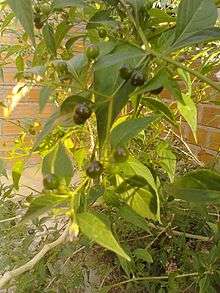Capsicum cardenasii
| Capsicum cardenasii | |
|---|---|
 | |
| C. cardensii plant with immature fruit | |
| Scientific classification | |
| Kingdom: | Plantae |
| (unranked): | Angiosperms |
| (unranked): | Eudicots |
| (unranked): | Asterids |
| Order: | Solanales |
| Family: | Solanaceae |
| Genus: | Capsicum |
| species complex: | Capsicum pubescens complex |
| Species: | C. cardenasii |
| Binomial name | |
| Capsicum cardenasii Heiser & P.G.Sm. | |
Capsicum cardenasii is a plant from the Solanaceous family and genus Capsicum of plants. It is a diploid with 2n=2x=24. It is a member within the C. pubescens complex, a group of closely related Capsicum species. It is closely related to C. eximium. It is native to the Andes, and it can be found in Bolivia.[1] The native name is ulupica.[2]
Vegetative characteristics
Capsicum cardenasii, like most members of the Pubescens complex, is a perennial plant that develops woody stems. The plant can grow up 2-3 feet high with a width of 1-1.5 feet. The leaves are narrow, lanceolate and pubescent. Plants generally produce between 1 and 2 flowers at the internodes. The petioles grow erect and have campanulate, pendant flowers.[3] The corolla is white and purple colored.[2] The plant produces small, fleshy, red fruit. It is likely the wild ancestor of rocoto peppers.[4]
The plant requires a cool, freeze free environment and long growing season similar to its native environment in the Andes.[1]
Reproduction
After fertilization C. cardenasii develops small round red berries, sometimes referred to as chiltepins. The fruits contain a small number of seed. The fruit are pungent, near 30 000 SHU (Scoville Heat Units), making them quite spicy.
Capsicum cardenasii is self-incompatible, exhibiting unilateral incompatibility.[5]
Uses
Its primary use is as a spice. Many wild Capsicums exhibit disease resistance of interest to plant breeders. C. cardenasii has been shown to be resistant to tobacco mosaic virus (TMV), and there is a possibility that one day this resistance may be transferred to other capsicum species through breeding.[2]
References
- 1 2 "Peppers: History and Exploitation of a Serendipitous New Crop Discovery". hort.purdue.edu. Retrieved 2016-01-29.
- 1 2 3 Pickersgill, Barbara (1997-07-01). "Genetic resources and breeding of Capsicum spp.". Euphytica. 96 (1): 129–133. doi:10.1023/A:1002913228101. ISSN 0014-2336.
- ↑ http://www.botany.wisc.edu/courses/botany_940/06CropEvol/papers/Walsh%2601.pdf
- ↑ "Taxonomy - GRIN-Global Web v 1.9.4.2". npgsweb.ars-grin.gov. Retrieved 2016-02-20.
- ↑ Onus, A. Naci; Pickersgill, Barbara (2004-08-01). "Unilateral Incompatibility in Capsicum (Solanaceae): Occurrence and Taxonomic Distribution". Annals of Botany. 94 (2): 289–295. doi:10.1093/aob/mch139. ISSN 0305-7364. PMC 4242164
 . PMID 15229125.
. PMID 15229125.